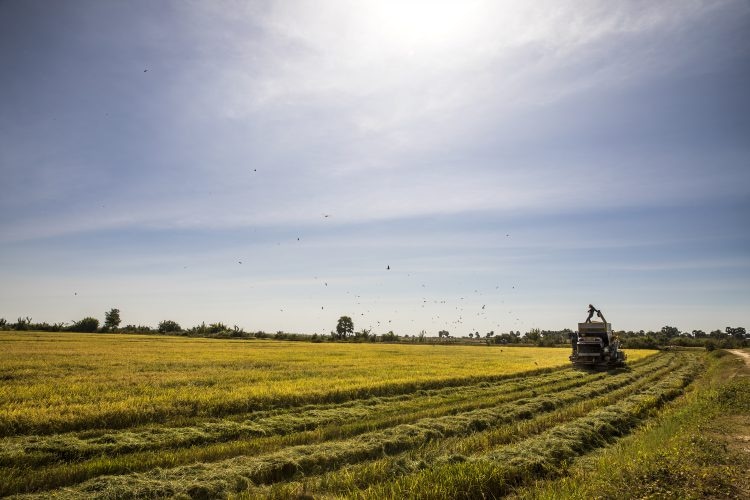Dec 5 2019
Rice is consumed by people around the world in their everyday diets. However, besides its nutrient and caloric content, rice can have small quantities of arsenic, which in large doses is a toxin associated with many health conditions and dietary-associated cancers.
 UW researchers found that warmer temperatures, at levels expected under most climate change projections, can lead to higher concentrations of arsenic in rice grains. Image Credit: Mark Stone/University of Washington.
UW researchers found that warmer temperatures, at levels expected under most climate change projections, can lead to higher concentrations of arsenic in rice grains. Image Credit: Mark Stone/University of Washington.
Scientists at the University of Washington have learned that warmer temperatures, at levels predicted under a majority of the climate change projections, can result in higher concentrations of arsenic in rice grains. Their findings will be presented at the American Geophysical Union’s Fall Meeting in San Francisco on December 10th.
“We know that more arsenic is released from soil at higher temperatures. Here we saw this response to temperature in the soil impact the arsenic content of rice grain,” stated senior author Rebecca Neumann, a UW associate professor of civil and environmental engineering.
Neumann continued, “We were working with soil that had relatively low arsenic levels, but the warmer temperatures still led to increased arsenic concentrations in the grains at ranges where we begin to have health concerns. If these results are representative of what we might expect for field-grown rice, then climate change could exacerbate the problem of arsenic-contaminated rice.”
Arsenic exists in the soil naturally, but its concentration is higher in areas that have traditionally used arsenic-based herbicides or where irrigation water has arsenic. When farmers cultivate crops like rice under flooded conditions, arsenic gets extracted from the soil and flows into the water.
In general, the plant is like a big tube or a straw as it draws water up from its roots to its leaves. And rice naturally takes up arsenic because the arsenic mimics other molecules that these plants preferentially draw out of the soil. It’s a perfect storm for concentrating arsenic.
Yasmine Farhat, Study Lead Author and Doctoral Student in Civil and Environmental Engineering, University of Washington
To establish whether rice would absorb more arsenic under warmer conditions, the team took soil from a paddy field in Davis, California. Returning to Seattle, the scientists cultivated rice in this soil in temperature-regulated growth chambers.
They compared the uptake of arsenic under four varied temperature conditions. Certain plants were cultivated under typical conditions for that part of California: 77 °F (25 °C) on average during the day.
Others were cultivated at incrementally warmer temperatures reflecting varied prospective levels of warming for that area by the end of this century: 82 °F (28 °C), 87 °F (30.5 °C), and 91 °F (33 °C). Compared to daytime, nighttime temperatures were 3.6 °F (2 °C) cooler for all plants.
With the increase in temperature, the team noticed increased uptake of arsenic to every part of the plant the scientists examined—including the rice grains.
For the stem and the leaves, it’s a clear step up in arsenic concentration as we increase the temperature. For the grains, the highest temperature made the plants so stressed out that they didn’t produce any grains. But these other two forecasts of increasing temperature show a similar increase of arsenic in the rice grains. Arsenic concentrations in the grain more than tripled between the low- and high-temperature treatments.
Yasmine Farhat, Study Lead Author and Doctoral Student in Civil and Environmental Engineering, University of Washington
Arsenic is a poison for rice plants as well, and they have mechanisms to guard themselves against higher levels of it. One technique involves stimulating a protein that sequesters arsenic in particular cells and tissues of the plant. However, when the scientists measured this protein’s expression levels in their plants at higher temperatures, they noticed no difference compared to the plants cultivated at present-day’s fairly low temperatures.
“Maybe the arsenic concentration was so low in our soil that the plant wasn’t ‘aware’ it needed to turn on its defense mechanism,” stated Farhat. “We haven’t been as concerned about these low-arsenic systems, but our data suggest that as temperatures start to warm, even rice grown in soil with low arsenic could be at risk for having higher levels of arsenic in the grains.”
Some forms of arsenic are more poisonous than others. The researchers have currently collaborated with scientists at UW Tacoma to formulate a method that would enable them to see what forms of arsenic are present in the various parts of the plant. Therefore, they can obtain a better picture of any probable health hazards to people.
Arsenic in all forms is bad for us, and it’s bad for the plants as well. Increasing arsenic can decrease crop yield. That can be economically bad for rice farmers. I want people to remember even if they are not eating a lot of rice, a lot of people are heavily relying on this crop. When we’re thinking and planning for the future, we need to remember that rice touches a lot of people and we should work together on that.
Yasmine Farhat, Study Lead Author and Doctoral Student in Civil and Environmental Engineering, University of Washington
Other study co-authors include Soo-Hyung Kim, a UW professor of environmental and forest sciences; Stuart Strand, a UW research professor of civil and environmental engineering; and Long Zhang, a UW research scientist in civil and environmental engineering.
This study was financially supported by a University of Washington Innovation Award; a National Science Foundation Innovations at the Nexus of Food, Energy, and Water Systems award; and a National Science Foundation Graduate Research Fellowship.